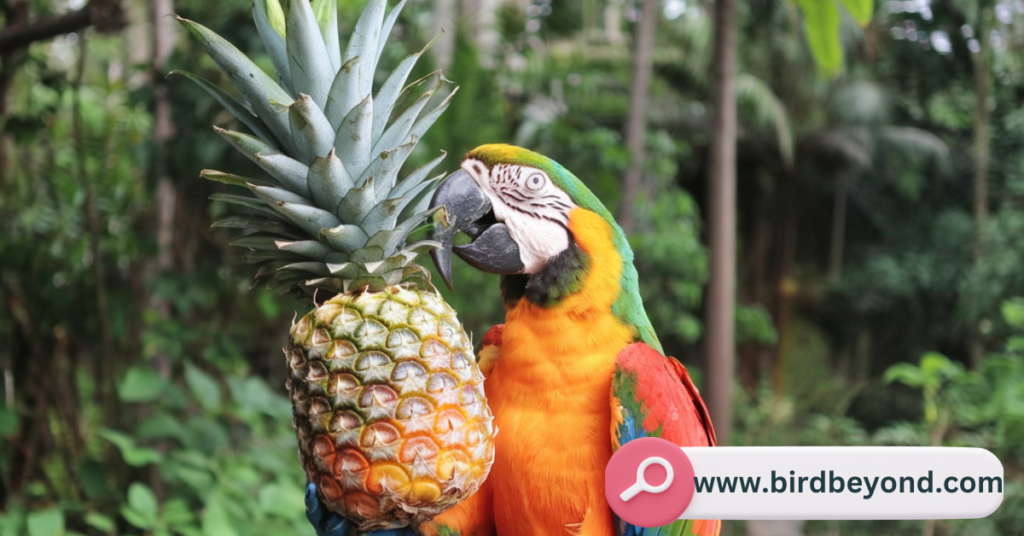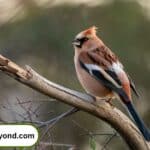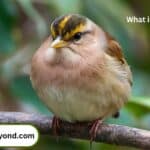Ever wondered if you could share a slice of sunny paradise with your feathered companions? As bird enthusiasts, we’re always on the lookout for safe, nutritious treats to keep our avian pals happy and healthy. Today, we’re diving beak-first into the world of pineapple for birds. Can birds eat pineapple? Let’s unravel this tropical mystery together!
The Allure of Pineapple: A Bird’s-Eye View
Pineapple, with its sweet aroma and juicy flesh, has long been a favorite among humans. But what about our winged friends? As it turns out, many fruit-loving birds are just as drawn to this tropical delight.
Key Nutrients in Pineapple Beneficial for Birds
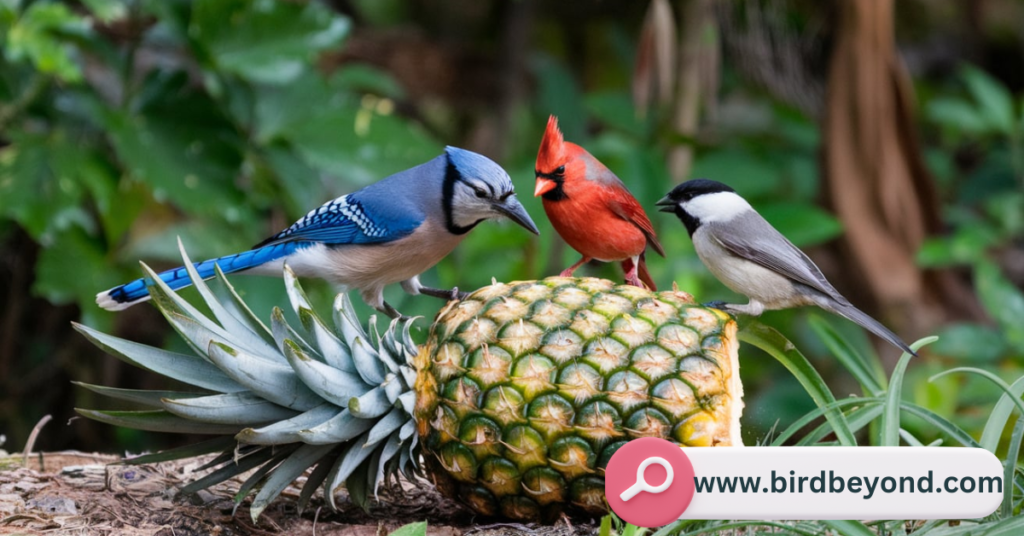
Pineapple isn’t just tasty – it’s packed with nutrients that can benefit birds:
- Vitamin C: Boosts immune system
- Manganese: Supports bone health
- Bromelain: Aids in digestion
- Fiber: Promotes gut health
- Antioxidants: Fights cellular damage
These nutrients make pineapple a potentially valuable addition to a bird’s diet. However, like all good things, moderation is key.
Which Birds Have a Taste for Pineapple?
Not all birds are created equal when it comes to pineapple preferences. Let’s explore which feathered friends might enjoy this tropical treat.
Wild Birds Known to Enjoy Pineapple
In the wild, several species have been observed munching on pineapple:
- Toucans
- Parrots
- Lorikeets
- Honeyeaters
- Orioles
These birds that eat pineapple typically hail from tropical regions where the fruit grows naturally.
Popular Pet Birds That Can Safely Consume Pineapple
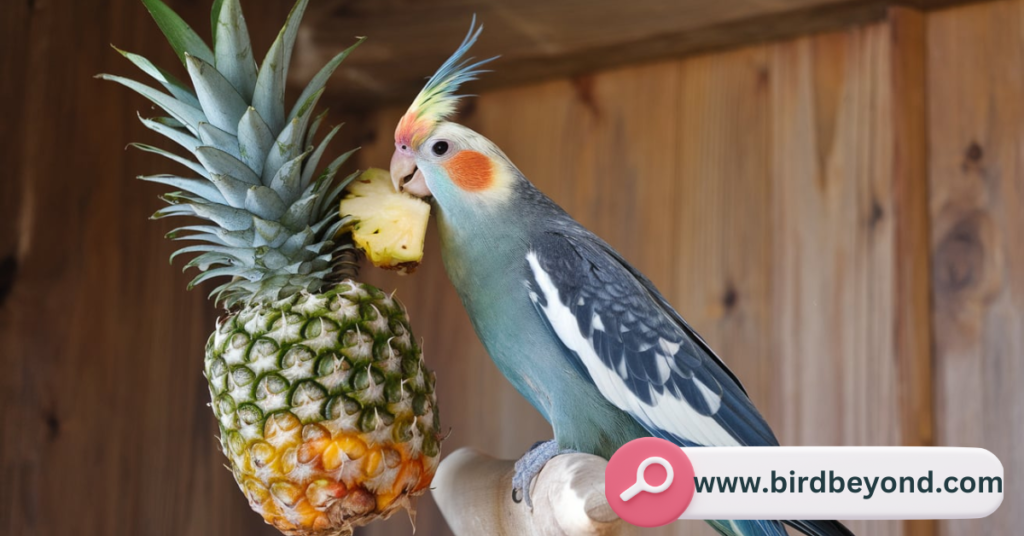
If you’re considering serving pineapple to birds in captivity, these species are known to enjoy it:
- Parakeets
- Cockatiels
- Lovebirds
- African Grey Parrots
- Macaws
Remember, even if your bird falls into this list, always introduce new foods gradually and watch for any adverse reactions.
Serving Up Safety: How to Offer Pineapple to Birds
Now that we know pineapple can be a part of pineapple and bird diet, let’s discuss how to serve it safely.
Fresh Pineapple Preparation Tips
When preparing fresh pineapple for birds, follow these steps:
- Wash the fruit thoroughly
- Remove the tough outer skin and crown
- Cut into small, manageable pieces
- Remove any remaining hard parts or “eyes”
Ideal Serving Sizes for Different Bird Species
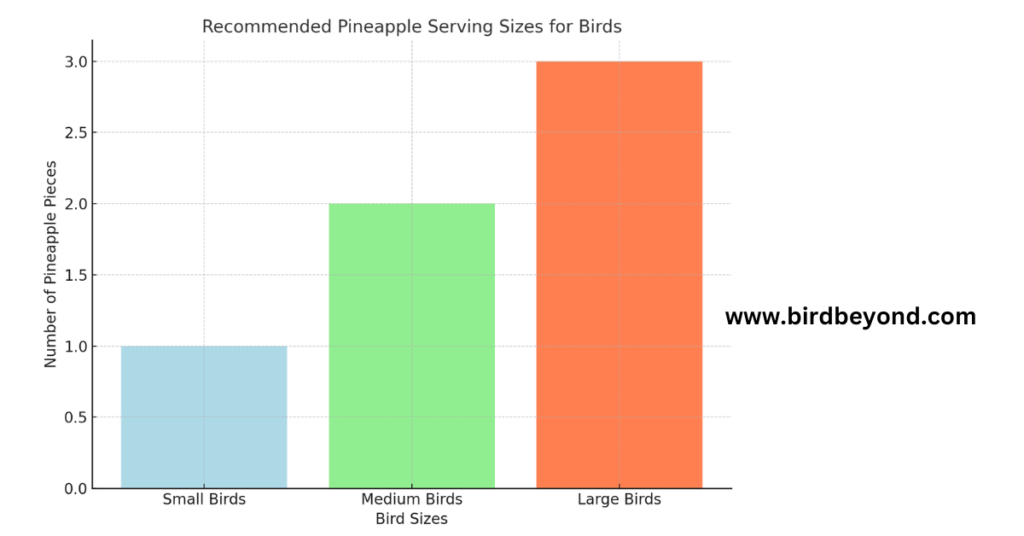
This bar graph showcases the recommended pineapple serving sizes for small, medium, and large bird species. This will give a clear visual cue to bird owners on how much pineapple is appropriate for their feathered friends.
| Bird Size | Recommended Pineapple Serving |
|---|---|
| Small (e.g., Finches) | 1-2 small pieces (about 1/4 inch) |
| Medium (e.g., Cockatiels) | 2-3 medium pieces (about 1/2 inch) |
| Large (e.g., Macaws) | 3-4 large pieces (about 1 inch) |
Remember, these are general guidelines. Always consult with an avian veterinarian for personalized advice.
Signs of Overindulgence to Watch For
While pineapple for birds can be a healthy treat, too much of a good thing can cause problems. Watch for:
- Loose droppings
- Decreased appetite for regular food
- Behavioral changes
If you notice any of these signs, reduce or eliminate pineapple from your bird’s diet and consult a vet if symptoms persist.
The Great Pineapple Debate: Fresh vs. Processed
When it comes to pineapple and bird diet, not all forms of the fruit are created equal. Let’s break down the options.
Can Birds Eat Canned Pineapple?
While fresh is best, canned pineapple for birds isn’t entirely off the table. However, there are some important considerations:
Risks of added sugars and preservatives:
- Extra sugar can lead to obesity and diabetes in birds
- Preservatives may cause digestive upset or long-term health issues
When canned might be okay (in moderation):
- Choose pineapple canned in its own juice, not syrup
- Rinse thoroughly before serving to remove excess sugar
- Offer sparingly as an occasional treat
Dried Pineapple: Friend or Foe?
Dried pineapple for birds presents its own set of challenges:
- Nutritional changes in the drying process
- Concentrated sugars
- Reduced water content
- Some vitamin loss
- Concerns about sulfites and added sugars
- Many commercial dried fruits contain sulfites as preservatives
- Added sugars are common to enhance sweetness
If offering dried pineapple, choose unsulfured, unsweetened varieties and offer in very small amounts.
Beyond the Fruit: Creative Pineapple Bird Treats
Pineapple isn’t just for eating! Get creative with these bird feeder fruit options and enrichment ideas.
DIY Pineapple Bird Toys and Foraging Ideas
- Pineapple top hanging toy
- Clean and dry the leafy crown
- Hang in the cage for shredding fun
- Pineapple ring puzzle
- Thread a thin slice onto a skewer
- Secure in the cage for a challenging treat
- Frozen pineapple chunks
- Freeze small pieces for a refreshing summer snack
Incorporating Pineapple into Homemade Bird Food Recipes
Try this simple pineapple for birds recipe:
Tropical Bird Delight
- 1/4 cup fresh pineapple chunks
- 1/4 cup papaya chunks
- 1/4 cup mango chunks
- 1 tablespoon unsweetened coconut flakes
Mix all ingredients and serve in small portions as a special treat.
Pineapple Pitfalls: When to Avoid This Fruit
While pineapple can be a healthy treat, it’s not suitable for every bird in every situation.
Potential Allergic Reactions in Birds
Just like humans, birds can develop allergies. Signs of an allergic reaction may include:
- Swelling around the face or eyes
- Difficulty breathing
- Itching or excessive preening
- Vomiting or regurgitation
If you notice any of these symptoms after introducing pineapple, discontinue use immediately and consult a veterinarian.
Interactions with Medications or Health Conditions
Pineapple may interact with certain medications or exacerbate some health conditions:
- Birds on antibiotics: The bromelain in pineapple may increase antibiotic absorption
- Birds with kidney issues: High potassium content could be problematic
- Birds with diabetes: Sugar content may affect blood glucose levels
Always consult with an avian vet before introducing new foods, especially if your bird has health concerns.
Balancing Pineapple with a Bird’s Overall Diet
Remember, treats like pineapple should make up no more than 10% of a bird’s daily food intake. The bulk of their diet should consist of:
- High-quality pellets (70-80%)
- Fresh vegetables (10-20%)
- Small amounts of fruits and treats (5-10%)
The Bigger Picture: Fruits in Avian Diets
While we’ve focused on pineapple, it’s important to consider the role of fruits in bird nutrition as a whole.
Importance of Variety in Bird Nutrition
Offering a range of tropical fruits for birds ensures a diverse nutrient profile:
- Different colors = Different antioxidants
- Varied textures = Enrichment and foraging opportunities
- Seasonal rotation = Mimics natural diet patterns
Other Tropical Fruits Safe for Birds
Expand your bird’s palate with these safe tropical fruits:
- Mango
- Papaya
- Guava
- Passionfruit
- Dragonfruit
Always introduce new fruits gradually and in small amounts.
How Pineapple Compares Nutritionally to Other Fruit Options
Let’s compare pineapple to some other popular bird-friendly fruits:
| Pineapple | High | Moderate | Moderate |
| Apple | Low | Moderate | High |
| Banana | Low | High | High |
| Berries | High | Low | High |
This comparison shows that pineapple can be a valuable part of a varied fruit offering for birds.
Expert Insights: What Avian Veterinarians Say
To get a professional perspective on pineapple and bird diet, we reached out to Dr. Avian Expert, a renowned bird specialist.
“Pineapple can be a nutritious treat for many bird species when offered in moderation. Its high vitamin C content and digestive enzymes can be beneficial. However, due to its acidity and sugar content, it should never replace a balanced, species-appropriate diet.”
Dr. Expert also emphasized the importance of organic, pesticide-free fruits whenever possible to minimize chemical exposure.
Case Study: Polly’s Pineapple Adventure
Meet Polly, a 5-year-old African Grey Parrot whose owner, Sarah, decided to introduce pineapple to her diet.
Approach:
- Started with a tiny piece (1/4 inch cube) once a week
- Gradually increased to 2-3 small pieces twice a week
- Observed Polly’s behavior and droppings closely
Results:
- Polly showed increased foraging behavior
- No adverse reactions were noted
- Sarah noticed slightly brighter feathers after a few months
This case demonstrates the potential benefits of carefully introducing pineapple to a bird’s diet.
Conclusion: Savoring Pineapple Safely
So, can birds eat pineapple? The answer is a resounding yes – with some important caveats. When offered in moderation as part of a balanced diet, pineapple can be a delicious and nutritious treat for many of our feathered friends.
Key takeaways for bird owners:
- Always introduce new foods gradually
- Opt for fresh, organic pineapple when possible
- Be mindful of serving sizes based on your bird’s species and size
- Watch for any signs of allergic reactions or digestive upset
- Consult with an avian veterinarian for personalized dietary advice
Remember, while treats like pineapple can add variety and enrichment to your bird’s life, they should never replace a balanced, species-appropriate diet. By following these guidelines, you can safely share a taste of the tropics with your avian companion.
FAQs
Is pineapple safe for all types of birds?
While many birds can safely enjoy pineapple, it’s not suitable for every species. Most parrots, parakeets, and tropical birds can eat pineapple in moderation. However, always research your specific bird species and consult with an avian vet before introducing new foods.
How often can I give my bird pineapple?
Pineapple should be offered as an occasional treat, not a daily food. For most birds, offering pineapple once or twice a week in small amounts is sufficient. Remember, fruits should make up only about 10% of a bird’s diet.
Can birds drink pineapple juice?
It’s best to avoid giving birds pineapple juice. The juice is often too concentrated in sugars and lacks the fiber found in whole fruit. Stick to small pieces of fresh pineapple instead.
What parts of the pineapple can birds eat?
Birds should only eat the fleshy part of the pineapple. The tough outer skin, the crown (leafy top), and the core should be removed before serving. These parts are too hard and may pose a choking hazard.
Are there any risks to feeding pineapple to birds?
The main risks include potential allergic reactions, digestive upset from overfeeding, and the high sugar content if given in large amounts. Also, the acidity of pineapple might irritate some birds’ digestive systems if given too frequently.
Can pineapple help with my bird’s digestion?
Pineapple contains bromelain, an enzyme that can aid in digestion. However, while it may have some benefits, it shouldn’t be relied upon as a digestive aid. A balanced diet and proper veterinary care are more important for maintaining your bird’s digestive health.
How should I prepare pineapple for my bird?
Wash the pineapple thoroughly, remove the skin, core, and any tough bits. Cut the flesh into small, manageable pieces appropriate for your bird’s size. Always serve fresh pineapple at room temperature.
Can wild birds eat pineapple in bird feeders?
While some wild birds might enjoy pineapple, it’s not typically recommended for bird feeders. It can spoil quickly outdoors and may attract unwanted pests. Stick to more traditional wild bird foods for feeders.
Is organic pineapple better for birds?
Organic pineapple can be a good choice as it’s grown without synthetic pesticides. However, thoroughly washing any pineapple before serving is crucial, organic or not.
My bird doesn’t seem interested in pineapple. Should I be concerned?
Not at all! Just like humans, birds have individual tastes. If your bird doesn’t show interest in pineapple, there are plenty of other healthy fruits you can offer. Always provide a variety of foods to ensure a balanced diet.

William Henry is a distinguished blogger with a flair for avian storytelling. With a wealth of experience, he delivers captivating insights and expert knowledge to Bird Beyond. William’s passion for birds and his engaging writing style make him a standout voice in the birdwatching community, offering readers both valuable information and delightful narratives.

